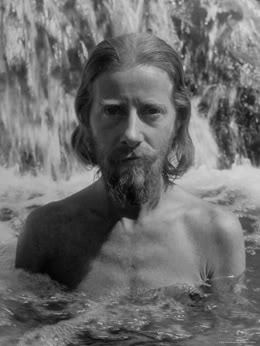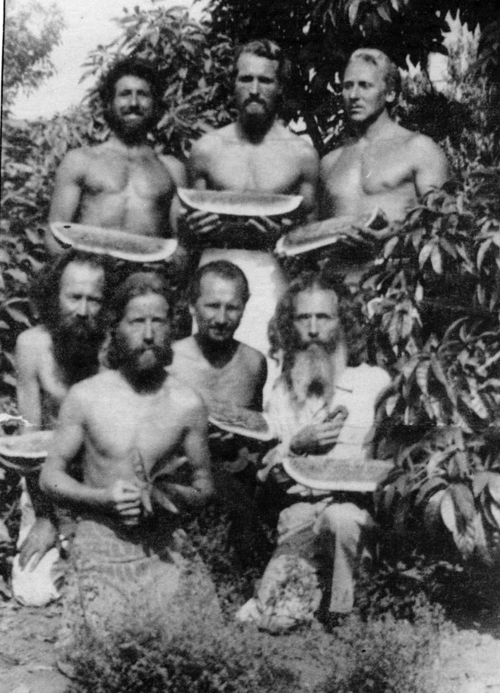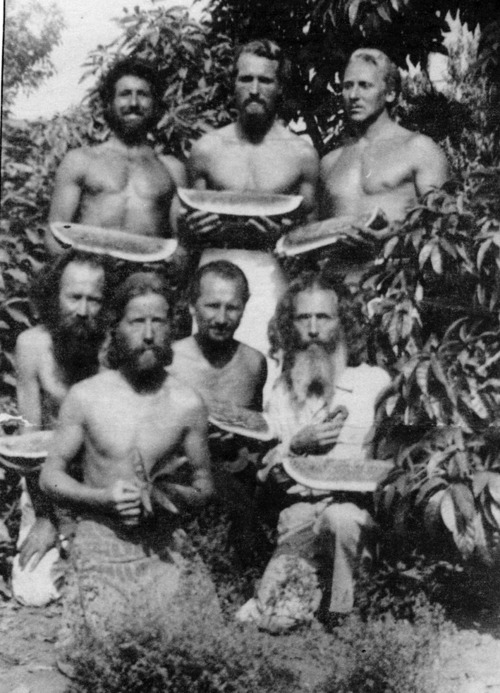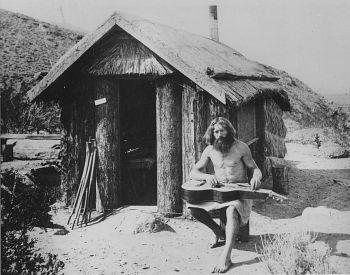Long before the more obvious cultural explosion of the 1960s, a group of Californians were cultivating an alternative lifestyle that would come to influence later movements and culture at large. They called themselves the Nature Boys.
From the early 1900s on, they wore their hair long, skin tanned from reverence of nature and the sun. Jack Kerouac mentions them in “On The Road”, telling us that while traveling through Los Angeles in 1947 he’d see“an occasional Nature Boy saint in beard and sandals”.
The Nature Boys were proponents of a vegetarian lifestyle, living primarily off of fruits and vegetables. In fact, a popular Nature Boy hangout was a a health food store in Los Angeles’ Laurel Canyon founded by German immigrants. The Eutropheon, Greek for “good nourishment”, was a bustling community center where lectures about raw foods and natural living took place.
- A prominent group of Nature Boys, including Eden Ahbez, lower left.
The group included Eden Ahbez, a musician and songwriter who often performed at the Eutropheon, playing piano, and flutes he made himself. He eventually wrote a hit for Nat King Cole, it’s title “Nature Boy” an obvious homage.
A frenzy ensued after the song hit number one for eight weeks straight, eventually to be performed by Frank Sinatra, Ella Fitzgerald, and Peggy Lee.
Despite the attention Ahbez brought the Nature Boys, they themselves often lived the lives of hermits, wandering the hills, taking up dwelling in trees and caves. Eden himself sometimes slept under the first L of the Hollywood sign.

- Eden Ahbez
The term Nature Boy was a loose translation of naturmenschen.Most of the practicing youth were either German immigrants or followers of German immigrants who taught what was calledLebensreform, or life-reform.
One early Lebensreform influencer and Nature Boy mentor was Bill Pester. He fled Germany at the age of 19 to avoid military service in 1906.
His philosophy of nature worship, passion for literature and writing, musicianship, nudism, and raw foods diet set the standard for the lifestyle.
He came to settle in Palm Springs where he often walked barefoot through the desert and played his guitar. Pester lived in a self-made cabin and was well liked by the local Native Americans. For some reason the Native American census at the time even included his name.
- Bill Pester at this palm log cabin in Palm Canyon, California, 1917.
At the outset of the 1960s, aging Nature Boys could be found at music festivals of the dawning era. They served as gurus and role models for the rebellious youth that would become known as Hippies. But the Nature Boys were not proponents of all aspects of Hippie culture.
The philosophy of Lebensreform and its strict adherence to natural lifestyles, diet, and yoga would have discouraged drug abuse.
Gordon Kennedy is the author of “Children of the Sun” a book that pins the origins of the Hippie Movement to 19th century Germany. The book is hard to find, available only for very high prices—around 1,000 dollars new. I found a relevant forum discussing the book and his 2003 article on the same subjects.
Kennedy says, “The California Nature Boys didn’t seem to have any interest at all in drugs, even though the Beat thing was dawning during the late 40’s, the beats were largely urban and into black jazz and urban nightlife, reefers etc. Nature Boys avoided urban scenes and smoke in any form.”
It seems the Beats, as well as Timothy Leary and his Harvard LSD researchers, brought the party favors. The Nature Boys provided a life model that worked once the party was over.
The American counterculture has deeper roots than we know, beyond the Hippies, and beyond even the Beats.
Distinguishing these movements from that of the Nature Boys andLebensreform teachers might change our minds about the Sixties, and even the modern consciousness movement taking hold worldwide right now.
The simple tale of middle class dropout youth is only the hippy tip of the iceberg. A deeper story extends into the 1940s with the Nature Boys, then into Lebensreform and health movements imported by German immigrants.
Question:
Were drugs the defining characteristic of 1960’s subculture? Can you think of other movements during or before this era that practiced a similar lifestyle (with or without the mind-altering substances)?

















